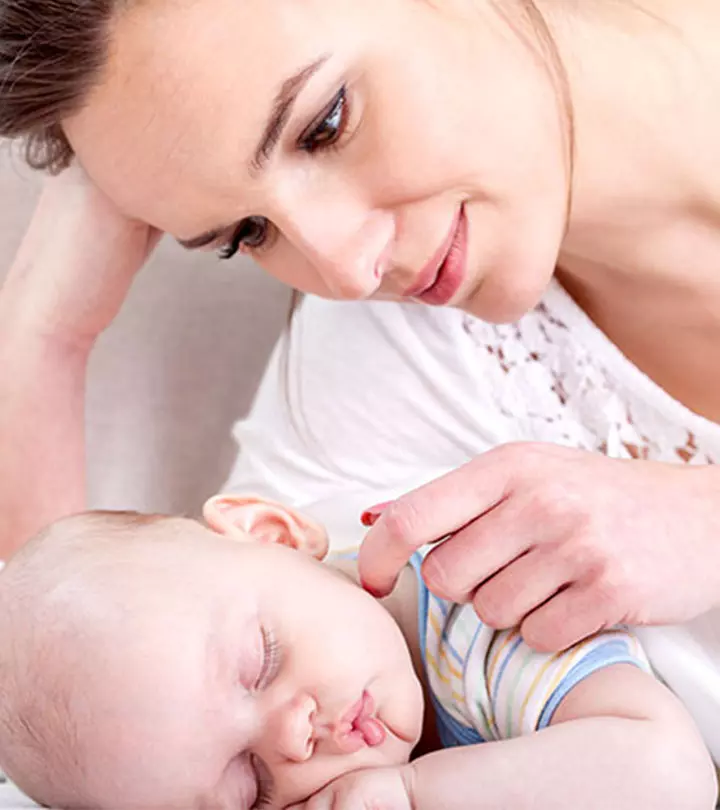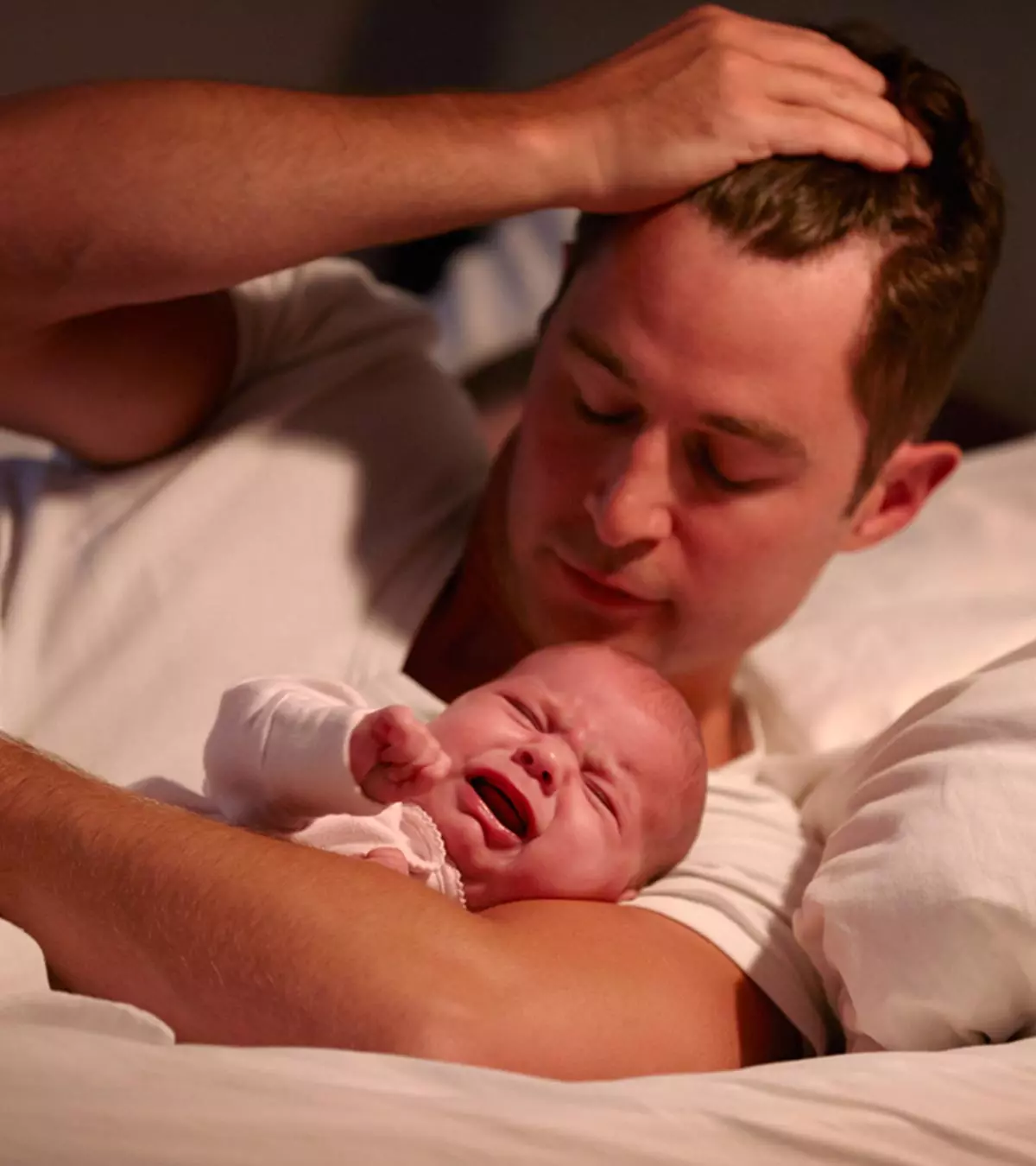
Image: Shutterstock
A common complaint new parents voice is how their baby cries when put down. Initially, it may seem adorable that the baby doesn’t want to be separated from you. However, as time passes, such dependency can create sleep deprivation in the babies and the parents. Are you a parent wondering what to do when your baby begins to cry the moment you put them down? To find a solution, you need to identify why your baby cries as soon as they are out of your arms. Read this post to understand some of the most common reasons babies start wailing when put down and tips to prevent it.

Key Pointers
- Babies may cry every time they are put down due to many factors such as separation anxiety, when adjusting to a new crib, or when disturbed from a comfortable position.
- You can teach them to self-soothe by sticking to a bedtime routine, feeding them before sleep, and soothing them with a massage.
- You can help them feel safe to stop the crying and never resort to any form of punishment.
Possible Reasons A Baby Cries When Put Down
Good sleep is important for a baby’s growth and development. According to the Centers for Disease Control and Prevention (CDC), newborns (0-3 months) require about 14-17 hours of sleep and about 12-16 hours of sleep, including naptimes for infants aged 4-12 months (15). However, excessive and frequent crying due to colic, sickness, or discomfort can disrupt a baby’s sleep.
Sometimes, a baby crying could mostly be behavioral or habitual, especially when you put them down, and rarely would it be due to a medical condition. Here are a few possible reasons a baby cries when you put them down.
1. Separation anxiety

Your baby was nestled in your warm and cozy womb for nine months, and so it is natural for them to feel safe and comfortable in your arms. Right from when they are born, babies like to have skin-to-skin contact or be held in your arms. Separation anxiety is normal in babies. Studies suggest that nearly all babies between the ages of 18 months and three years have separation anxiety and are clingy to some extent (1).
So, if your baby is happy and content in your arms or lap but starts to wiggle and squirm as soon as you place them in a crib, it is most probably separation anxiety.
Pierrette Mimi Poinsett, MD, a California-based pediatrician, says, “It is very normal for a young infant to cry when being put down. The first four months of age is also known as the 4th trimester. It is a transitional time between being in the womb and being outside of the womb. Babies in this age range have a preference for being tightly held, rocked, and listening to white noise.”
2. New crib or room
Babies need time to adjust to changes. Whether it is a new crib or their nursery, your baby might refuse to sleep in them initially. If they have been sleeping in your bed (in a co-sleeping crib) for a while, and you have now decided to shift them to their new crib in the nursery, they might cry as their body senses the new surroundings (16).
3. Nursing
Your baby falls asleep in your lap while nursing, but as soon as you put them down, they start to cry. Does this sound familiar? It is pretty common among newborns. As their belly starts to get full, they tend to drift off to sleep. According to the Australian Breastfeeding Association, when breastfeeding, the mother’s body releases a hormone, cholecystokinin (CCK), which makes the baby sleepy (17). However, when babies get disturbed from that comfortable position, they might start to cry.
4. Increased crying

If your baby cries excessively throughout the day, it might be due to colic, or they might be going through the PURPLE crying period. Infantile colic or colic in babies is defined as fussing or crying for more than three hours per day, for more than three days of the week. It is a common and self-limiting condition (2).
Purple crying is a period when the baby may cry more each week between two and five months of age. This, too, resolves on its own (3).
 Be watchful
Be watchful5. Hunger
One of the prime reasons behind an infant crying is hunger. As newborns do not know any other way to communicate their needs, they tend to cry when hungry (18). Ensure your feeding schedule is on track and keep your baby’s belly full.
6. Absence of a routine
Babies sleep peacefully when they settle into a routine. When they are fed or put down to sleep at the right time, they are less likely to cry and fuss. This could be because they have clear expectations regarding their nap time or mealtime. However, absence or any change in routine can make them fussy and cry (13).
7. Need for attention

Sometimes, older babies fuss and cry when put down to grab your attention (14). If your baby is accustomed to being carried around, they might cry when you put them down or leave them alone.
8. Startle reflex
The Moro (startle) reflex in babies is present from birth until a baby turns three to four months. It may cause the babies to cry during sudden movement, including whenever they are put down. Loud sounds can also trigger this reflex, and sometimes, babies’ own cries can also cause a startle reflex. Other than crying, the baby will throw their head back, throw their arms and legs sideways, and flex their thumbs (4) (5).
9. Inability to self-soothe
Newborns and babies as young as three months cannot control their emotions. Thus, they can’t self-soothe and need their parent or caregiver’s attention for comfort and support. However, as babies grow older, typically between three and four months, they may develop self-soothing skills. But if the baby is past the newborn stage and still cries whenever put down, you can train your baby to self-soothe (6).
If the reason behind your baby’s crying is behavioral or physiological, you can resolve it by following some simple steps. However, if your baby cries excessively, and it interferes with their sleep and feed schedule, it is best to consult your pediatrician.
How To Put Your Baby To Bed Without Them Crying
With small changes and a little more patience, you can train your baby not to cry when you put them down. It is essential to teach them how to self-soothe so that both you and the baby can have a good night’s sleep.
- Sleep train them. There are various methods to sleep train your baby and help them fall asleep without crying when you put them down. Sleep training also helps your little one develop self-soothing skills. You could opt for either of these two sleep training methods: the ‘cry it out,’ methodiThis method involves putting babies into the crib once they are fed, and changed for a clean diaper. You should not pick your baby up or out of he crib until the next nighttime feed or the morning. or the ‘no tearsiThis method involves picking the baby up and putting them down when they begin to cry or fuss during the night (also known as pick up, put down),’ method. Choose the one that is comfortable for you and your baby (13).
Mother of an eight-month-old baby, Dwija Patel, sleep-trained her baby. Sharing her experience, she says, “When I heard the word sleep training, it was mostly captured as a ‘cry-it-out’ method. It sounded like a loaded phrase. Eventually, I learned that controlled crying is fine if it leads to better sleep. My perception about it changed. It brought good energy and established a better day schedule for both of us (i).”
 Point to consider
Point to consider- Put them in the crib in a half-sleep state. If your baby tends to fall asleep while nursing, and it leads to separation anxiety in them, put them in the crib when they are in a half-sleep state, meaning when they are on the verge of drifting into a deep sleep (19).
Dr. Poinsett recommends, “Try putting your infant down when they are drowsy and not fully asleep. Also, if your baby seems inconsolable and you are stressed out, give yourself a brief timeout and put the baby down on their back in their crib. “Cry it out” is not recommended for newborns. However, a brief period of crying is not harmful to newborns.”

- Use soothing techniques. It is normal for your baby to cry when you move them from a comfortable position (from your arms or lap). The best way to stop this habit of theirs is by not rushing to them and taking them into your arms as soon as they start to cry. Try to soothe them by placing them inside the crib and gently patting them.
Charita Csiky, M.D., FAAP, a pediatrician at Hackensack Meridian Children’s Health in Eatontown, New Jersey, says, “It can be difficult to hear your baby cry, and not want to immediately lift them for comfort, but you want your baby to learn how to fall asleep on their own, in their new bed. If you hold your baby to fall asleep, if they wake up, it can cause distress to notice they’re in a new environment, and you are not there. It’s best to let them learn to fall asleep in the crib, on their own (16).”
- Accustom them to the new crib slowly. If your baby is used to co-sleeping, it could be a challenge to make them stop crying when put down. Settling a baby requires a gradual transition, requiring you to go one step at a time (16). Take the baby into the room or crib before their naptime, read them a book while they lie in the crib, or show them around in the nursery until it is their bedtime. This would familiarize them with the nursery, and they may not cry once you put them down.
 Quick tip
Quick tip- Dream feed them. If the reason behind your baby’s crying is hunger, try dream feeding them one last time before you go to bed. This may help your baby sleep through the night without feeling hungry (20).
- Stick to a routine. A feeding or bedtime routine can do wonders for your baby. Create a routine and stick to it. This would let your baby associate sleep or feeding with the routine and make them less dependent on you. Additionally, simple activities like a warm bath, reading a book, or singing a lullaby can signal to your baby that bedtime is approaching and make them more likely to settle down without crying. A routine will also ensure that you do not miss your baby’s sleep window (19).
 Expert says
Expert says- Give them a massage or a bath. Oil massage or a warm relaxing bath may also be helpful in comforting a crying baby (21) (22). This will also give them the needed physical touch to make them feel secured and safe.

- Spend time with them. Do not make it a habit to carry your baby around, as this will make them dependent. Instead, place them on a play mat or a baby carrier, and let them play independently. If they cry, you can sit and play with them for some time to make them feel safe and comfortable. This is called ‘The Chair’ sleep training method (13).
- Swaddle the baby. Swaddling mimics the womb, allows crying babies to relax, and helps put them to sleep. Make sure to swaddle the baby using lightweight blankets, snug around the arms, but keep the blanket loose at the hip to allow movement (22). Also, the American Academy of Pediatrics (AAP) advises against swaddling the baby once they start to roll over at around 2 months of age (23).
Frequently Asked Questions
1. How can I get my baby to sleep without being held?
Wearing a baby in a sling may promote sleep in babies, but they should be done safely. You may softly sing and use the ‘hands-on settling’. Here, you place your calm and drowsy baby in the crib/cot awake and gently pat and stroke them to help them fall asleep. You may comfort them with gentle ‘ssshhh’ sounds (7) (8).
2. Why does my baby hate lying flat?
Babies with acid reflux may find it uncomfortable, at times, to lie flat on their backs. However, there is no risk of choking in this position as babies automatically cough up or swallow fluid that they spit up due to the gag reflex. Back sleeping is the only recommended position until babies can roll over independently, as it is the best way to reduce the risk of sudden infant death syndrome (SIDs) (9).
3. Should I pick up my baby every time they cry?
Crying is one of the primary ways babies communicate their basic needs. However, sometimes, they may be crying due to reflux or gas. Hence, you should respond to your baby’s cries immediately in the first few months. Even if you do not pick them up every time, you may pat or cuddle them and make soothing sounds. Responding to a baby’s cries and giving them prompt attention will not spoil them at this age (10). However, as the baby grows, you should gradually train them to self-soothe. Most babies can self-soothe by six months of age (11).
While it may sometimes be draining, it is normal that a baby cries when put down, and simple techniques can help manage the crying. If your baby only stops crying when you are holding them, it may be because they want you near and have not yet learned to soothe themselves. Be patient with them and give them time to adjust. If maintaining a bedtime routine, feeding them, or soothing them in the crib do not work and they continue to cry for long hours, consult your child’s doctor to identify any underlying issue.
Infographic: More Points To Check About A Baby Crying When Put Down
Baby crying when put down, especially for sleep, is not an uncommon phenomenon experienced by most new parents. Although newborns like to be held for several reasons, you may use the tips mentioned in the infographic below to put your baby down after sleeping.
Some thing wrong with infographic shortcode. please verify shortcode syntax
Illustration: Tips To Handle A Baby Who Cries When Put Down To Sleep

Image: Stable Diffusion/MomJunction Design Team
Personal Experience: Source
MomJunction articles include first-hand experiences to provide you with better insights through real-life narratives. Here are the sources of personal accounts referenced in this article.
i. My sleep training journey;https://dwija-rp.medium.com/my-sleep-training-journey-a0ebf10e260e
References
Community Experiences
Join the conversation and become a part of our nurturing community! Share your stories, experiences, and insights to connect with fellow parents.
Read full bio of Dr. Neema Shrestha
- Dr. Pierrette Mimi Poinsett is a licensed pediatrician and a health advocate with 19 years of experience. She completed her doctor of medicine from the University of Chicago Pritzker School of Medicine and is currently practicing as a medical consultant in California.
 Dr. Pierrette Mimi Poinsett is a licensed pediatrician and a health advocate with 19 years of experience. She completed her doctor of medicine from the University of Chicago Pritzker School of Medicine and is currently practicing as a medical consultant in California.
Dr. Pierrette Mimi Poinsett is a licensed pediatrician and a health advocate with 19 years of experience. She completed her doctor of medicine from the University of Chicago Pritzker School of Medicine and is currently practicing as a medical consultant in California.
Read full bio of Rohit Garoo
Read full bio of Dr. Ritika Shah
Read full bio of Vidya Tadapatri

















